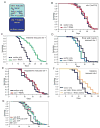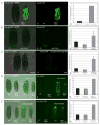The cell-non-autonomous nature of electron transport chain-mediated longevity
- PMID: 21215371
- PMCID: PMC3062502
- DOI: 10.1016/j.cell.2010.12.016
The cell-non-autonomous nature of electron transport chain-mediated longevity
Abstract
The life span of C. elegans can be increased via reduced function of the mitochondria; however, the extent to which mitochondrial alteration in a single, distinct tissue may influence aging in the whole organism remains unknown. We addressed this question by asking whether manipulations to ETC function can modulate aging in a cell-non-autonomous fashion. We report that the alteration of mitochondrial function in key tissues is essential for establishing and maintaining a prolongevity cue. We find that regulators of mitochondrial stress responses are essential and specific genetic requirements for the electron transport chain (ETC) longevity pathway. Strikingly, we find that mitochondrial perturbation in one tissue is perceived and acted upon by the mitochondrial stress response pathway in a distal tissue. These results suggest that mitochondria may establish and perpetuate the rate of aging for the whole organism independent of cell-autonomous functions.
Copyright © 2011 Elsevier Inc. All rights reserved.
Figures







Comment in
-
Mitochondrial stress signals revise an old aging theory.Cell. 2011 Jan 7;144(1):11-2. doi: 10.1016/j.cell.2010.12.023. Cell. 2011. PMID: 21215364
References
-
- Aamodt EJ, Chung MA, McGhee JD. Spatial control of gut-specific gene expression during Caenorhabditis elegans development. Science (New York, NY. 1991;252:579–582. - PubMed
-
- Apfeld J, Kenyon C. Cell nonautonomy of C. elegans daf-2 function in the regulation of diapause and life span. Cell. 1998;95:199–210. - PubMed
-
- Arantes-Oliveira N, Apfeld J, Dillin A, Kenyon C. Regulation of lifespan by germ-line stem cells in Caenorhabditis elegans. Science (New York, NY. 2002a;295:502–505. - PubMed
-
- Arantes-Oliveira N, Apfeld J, Dillin A, Kenyon C. Regulation of Life-Span by Germ-Line Stem Cells in Caenorhabditis elegans. Science. 2002b;295:502–505. - PubMed
Publication types
MeSH terms
Grants and funding
LinkOut - more resources
Full Text Sources
Other Literature Sources
Molecular Biology Databases

